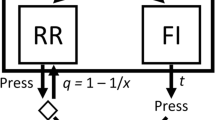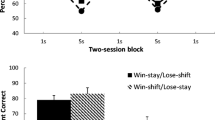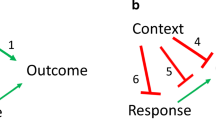Abstract
Rats (N=56) were trained in a runway under increasing (I), decreasing (D), and random (R) conditions of delay. Each group was then split with one-third of Ss being extinguished under I, D, and R conditions of delay-box confinement. Both delay patterns in training and confinement patterns in extinction affected resistance to extinction. The results were considered in terms of: (a) cognitive-dissonance theory; (b) the work of Marx, et al. on ordered variations in incentives; and (c) previous work which has demonstrated the importance of delay-box confinement in extinction and the direction of shifts in delay from training to extinction.
Similar content being viewed by others
References
ANDERSON, N. H. 1963. Comparison of different populations: Resistance to extinction and transfer. Psychol. Rev., 70, 162–179.
DEWS, P. 1960. Free-operant behavior under conditions of delayed reinforcement: I. CRF-type schedules. J. exp. anal. Beh., 3, 221–234.
EDWARDS, A. L. 1960. Experimental design in psychological research. New York: Rinehart (Rev. ed.).
FERSTER, C. B. 1953. Sustained behavior under delayed reinforcement. J. exp. Psychol., 45, 218–224.
LAWRENCE, D. H., & FESTINGER, L. 1962. Deterrents and reinforcement: The psychology of insufficient reward. Stanford: Stanford Univ. Press.
MARX, M. H., & EDWARDS, D. C. 1966. Speed of nonreinforced running response following increasing and decreasing orders of sucrose concentrations. J. exp. Psychol., 71, 160–161.
SCHOONOVER, J., & LAWRENCE, D. H. 1962. Resistance to extinction as a function of the number of delay trials. Psychol. Rep., 11, 275–278.
TOMBAUGH, T. N. 1966. Resistance to extinction as a function of the interaction between training and extinction delays. Psychol. Rep., 19, 791–798.
TOMBAUGH, T. N., & MARX, M. H. 1965. Effects of ordered and constant sucrose concentrations on nonreinforced performance. J. exp. Psychol., 69, 630–636.
WIKE, E. L., & McWILLIAMS, J. 1967. Duration of delay, delay-box confinement, and runway performance. Psychol Rep.
WIKE, E. L., MELLGREN, R. L., & WIKE, S. S. 1968. Runway performance as a function of delayed reinforcement and delay-box confinement. Psych. Rec. 18
WIKE, E. L., PLATT, J. R., PARKER, L. 1965. Patterns of delayed reinforcement and resistance to extinction. Psychonom. Sci., 3, 13–14.
Author information
Authors and Affiliations
Additional information
This research was supported by a grant GB 4299 from the National Science Foundation.
Rights and permissions
About this article
Cite this article
Wike, E.L., Sheldon, S.S. & Cour, C.A. Instrumental Performance as a Function of Increasing and Decreasing Delays of Reinforcement. Psychol Rec 18, 19–24 (1968). https://doi.org/10.1007/BF03393735
Published:
Issue Date:
DOI: https://doi.org/10.1007/BF03393735




